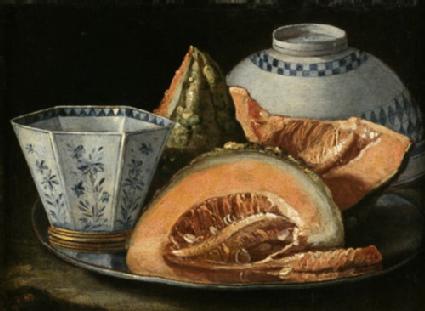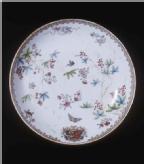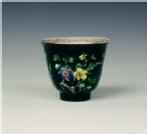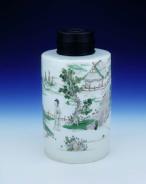Chinese Ceramics & the Early Modern World
4. European Markets
Individual pieces of porcelain had been making their way into Europe since before the turn of the sixteenth century. In 1499 the Portuguese explorer Vasco da Gama (d. 1524) brought home several pieces from India, which he presented to Dom Manuel I (r. 1495-1521), who soon began commissioning objects decorated with his own coat of arms. Throughout the sixteenth century, Chinese porcelain remained extremely rare in Europe, and was often mounted in silver or gold to emphasise its value. The first major shipments of Chinese porcelain did not arrive in Europe until the turn of the seventeenth century, when the Dutch captured two Portuguese vessels laden with Chinese goods and sold them in Amsterdam. These cargoes are said to have caused such excitement that all the crowned heads of Europe sent envoys to acquire these exotic goods at any price.

Cristoforo Munari (1667-1720). A Still-Life with Melon. Oil on canvas. 22.2 x 29.9 cm.
Private collection (ex The Lodi Collection, Campioni d’Italia).
The establishment of the Dutch East India Company in 1602 ensured a more regular supply of Chinese manufactured goods to European consumers. The Dutch conveyed their demands for unfamiliar shapes and styles to the Chinese middlemen, relying on metalware or coarse stoneware samples to illustrate what the required butter dish, gin bottle or rolwagen should look like. Europeans were soon afflicted with what Augustus II the Strong (1670-1733), Elector of Saxony and later King of Poland, termed ‘la maladie de porcelaine’. Among the many pieces in Augustus’ own collection was the cup with floral motif included here
should look like. Europeans were soon afflicted with what Augustus II the Strong (1670-1733), Elector of Saxony and later King of Poland, termed ‘la maladie de porcelaine’. Among the many pieces in Augustus’ own collection was the cup with floral motif included here . Over the next two centuries, European merchants imported at least 70 million pieces of Chinese porcelain.
. Over the next two centuries, European merchants imported at least 70 million pieces of Chinese porcelain.




